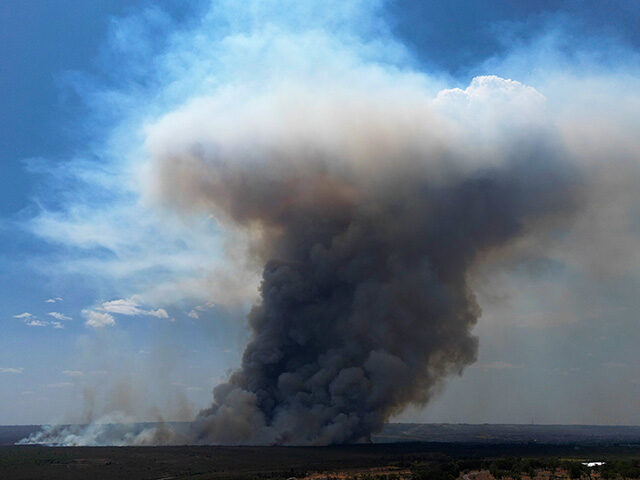Smoke from thousands of out-of-control fires in the Amazon Rainforest in Brazil is covering as much as 80 percent of the country, several outlets reported over the weekend.
Local emergency personnel in some of Brazil’s largest cities have documented a dramatic increase in the number of people seeking medical help for respiratory problems; in Brasilia, the national capital, the number of such cases has multiplied by 20. Experts asserted that inhaling smoke from the fires can cause effects comparable to smoking four or five cigarettes a day.
Nearly 60 percent of the Amazon Rainforest occupies Brazilian territory. The Amazon, the world’s largest tropical rainforest, faces recurring fires every year that in recent times became an international political controversy during the administration of conservative Brazilian President Jair Bolsonaro, who served from 2019 to 2022. Bolsonaro was the target of several campaigns led by Hollywood celebrities and international heads of state to condemn the former Brazilian government for the “destruction” of the rainforest.
Presently, under the socialist government of radical leftist President Luiz Inácio Lula da Silva, the Amazon Rainforest is experiencing the most severe fires in over a decade. Despite the dire situation, the loud international outrage seen under the Bolsonaro administration has not resurfaced.
According to statistics from Brazil’s National Institute for Space Research (INPE) reported by the local outlet Poder 360 on Tuesday, Brazil ended September with 83,157 documented fires, making it the worst month in 2024 so far and representing a 78.74-percent increase from September 2023’s 46,498 fires.
INPE has documented 210,208 fires in 2024 so far as of Tuesday, at an average of 210.2 per day — a number that, according to Poder 360’s report, surpasses the average of 197.6 fires per day logged in 2019 during the first year of Bolsonaro’s presidency. In 2007, during Lula’s second presidential term, Brazil experienced its worst forest fire rate in 26 years at an average of 393.9 fires per day.
Karla Longo, an atmospheric chemistry and pollutant dispersion specialist at INPE, told the local newspaper O Globo last week that the smoke cloud from the fires had spread to 80 percent of Brazil, extending across 7 million square kilometers (some 2.7 million square miles).
Longo explained that the smoke spread through the “flying rivers” of the Amazon Rainforest, air channels that normally exist in the atmosphere and distribute humidity during rainy seasons — but, she explained, carry smoke during fires beyond the rainforest.
The scientist explained that the smoke has not only spread over a larger area, but stressed that it can remain in the atmosphere for up to ten days, devastating air quality in the country and carrying tiny particles from everything burned by the fires that are harmful to health, in addition to other pollutants.
“These are long-term effects. It is high time for Brazil to prioritize combating fires. The situation should improve by the end of the month in the Southeast. But the Amazon will not see relief soon,” Longo said. “The drought in the north region is expected to continue at least until the end of October.”
A report recently published by the left-wing Brazilian newspaper Folha de Sao Paulo stated that at least 40 percent of of the population of the southern cities of Belo Horizonte and São Paulo said they experienced health complications from the fires, while 29 percent of the citizens in Rio de Janeiro and 27 percent of Recife’s inhabitants also reported similar health complications.
The situation has reportedly led to locals wearing masks, placing wet towels and buckets of water near fans in their homes, and a temporary suspension of classes in nearly 40 schools in the capital city of Brasilia, where local authorities recommended residents stay hydrated and avoid outdoor exercise.
Mariana Veras, head of the Environmental Pathology Laboratory at São Paulo’s Hospital das Clínicas, claimed to G1 on Tuesday that, unlike the masks and other protective equipment used by firefighters, wearing a common sanitary mask does not protect against the smoke’s health risks.
“It is a particulate material and the gases will pass through,” she asserted. “The N95 [mask] helps protect against particles, but unfortunately it is not enough.”
Veras warned that those who live within 50 kilometers (31 miles) from areas where fires occur are at an increased risk of lung cancer and other risks such as bronchitis, asthma, and even heart attacks in people who present cardiovascular problems.
Veras suggested local inhabitants moisten and seal their homes to prevent smoke from entering, drink plenty of fluids, avoid exercise on smoky days, monitor air quality, and pressure public authorities to fight for a “quality environment, and as quickly as possible.”
Christian K. Caruzo is a Venezuelan writer and documents life under socialism. You can follow him on Twitter here.

COMMENTS
Please let us know if you're having issues with commenting.